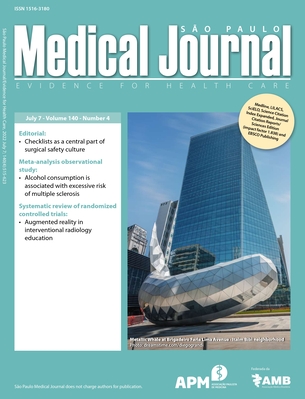Awareness towards stroke among high school students in Brazil:
a cross-sectional study
Keywords:
Stroke, Risk factors, Education, Awareness, Surveys and questionnairesAbstract
BACKGROUND: Stroke is one of the main causes of death worldwide. Educational interventions on stroke are potentially effective in reducing the period between the onset of symptoms and the initial emergency medical assistance. OBJECTIVE: To assess high school students’ knowledge of stroke. DESIGN AND SETTING: Cross-sectional study conducted in high schools in northeastern Brazil. METHODS: A self-structured questionnaire survey regarding stroke awareness was applied among high school students in northeastern Brazil. Data were collected between 2018 and 2019. The chi-square test and other descriptive statistics were used. Univariate and multivariate analyses were performed using logistic regression. RESULTS: A total of 1,788 students were analyzed. Eighty percent (n = 1430) of them did not have the minimum knowledge on how to act in a stroke situation. Only 10% (n = 179) presented the ideal knowledge on how to act. Males presented lower levels of knowledge on risk factors (odds ratio, OR: 0.62%; 95% confidence interval, CI: 0.49-0.79) and signs and symptoms of stroke (OR: 0.63%; 95% CI: 0.52-0.77). Students with ≥ 10 years of schooling (OR: 1.64%; 95% CI: 1.30-2.07) demonstrated greater knowledge of signs and symptoms of stroke. Students aged 18 years (OR: 1.70%; 95% CI: 1.14-2.52) demonstrated greater knowledge than other ages regarding the telephone number of the emergency medical services. CONCLUSIONS: There was a knowledge deficit with regard to recognizing stroke and activating the emergency medical services. The findings apply to the sample investigated and suggest that there is a need for stroke educational interventions, starting in high school.
Downloads
References
GBD 2016 Stroke Collaborators. Global, regional, and national burden of stroke, 1990–2016: a systematic analysis for the Global Burden of Disease Study 2016. Lancet Neurol. 2019;18(5):439-58. PMID: 30871944; https://doi.org/10.1016/S1474-4422(19)30034-1.
Rodrigues MDS, Santana LF, Galvão IM. Fatores de risco modificáveis e não modificáveis do AVC isquêmico: uma abordagem descritiva. Revista de Medicina. 2017;96(3):187-92. https://doi.org/10.11606/issn.1679-9836.v96i3p187-192.
Rodrigues MDS, Santana LF, Leal DB, Gomes OV. Diferenças entre os sexos e faixas etárias na epidemiologia acidentes vasculares cerebrais isquêmicos em um hospital de Uberlândia entre 2011 e 2015. Revista de Medicina. 2018;97(2):135-40. https://doi.org/10.11606/issn.1679-9836.v97i2p135-140.
Hawkes MA, Ameriso SF, Willey JZ. Stroke knowledge in Spanish-speaking populations. Neuroepidemiology. 2015;44(3):121-9. PMID: 25871697; https://doi.org/10.1159/000381100.
Marques MT, Guachala MC, Schoeps VA, et al. Popular knowledge of stroke in São Paulo: a cross-sectional study within the World Stroke Campaign. Sao Paulo Med J. 2021;139(2):117-122. PMID: 33729417; https://doi.org/10.1590/1516-3180.2020.0116.R1.18112020.
Fussman C, Rafferty AP, Lyon-Callo S, Morgenstern LB, Reeves MJ. Lack of association between stroke symptom knowledge and intent to call 911: a population-based survey. Stroke. 2010;41(7):1501-7. PMID: 20466995; https://doi.org/10.1161/STROKEAHA.110.578195.
Yarnoff B, Khavjou O, Elmi J, et al. Estimating Costs of Implementing Stroke Systems of Care and Data-Driven Improvements in the Paul
Coverdell National Acute Stroke Program. Prev Chronic Dis. 2019;16:E134. PMID: 31580797; https://doi.org/10.5888/pcd16.190061.
van Dishoeck AM, Dippel DW, Dirks M, et al. Measuring Quality Improvement in Acute Ischemic Stroke Care: Interrupted Time Series Analysis of Door-to-Needle Time. Cerebrovasc Dis Extra. 2014;4(2):149-
PMID: 25076959; https://doi.org/10.1159/000363535.
Thapa L, Sharma N, Poudel RS, et al. Knowledge, attitude, and practice of stroke among high school students in Nepal. J Neurosci Rural Pract. 2016;7(4):504-9. PMID: 27695228; https://doi.org/10.4103/0976-3147.188635.
Galindo Neto NM, Carvalho GCN, Castro RCMB, et al. Teachers’ experiences about first aid at school. Rev Bras Enferm. 2018;71(suppl 4):1678-84. PMID: 30088640; https://doi.org/10.1590/0034-7167-2017-0715. Erratum in: Rev Bras Enferm. 2018;71(suppl 5):2348.
Umar AB, Koehler TJ, Zhang R, et al. Stroke knowledge among middle and high school students. J Int Med Res. 2019;47(9):4230-41. PMID: 31307252; https://doi.org/10.1177/0300060519858887.
Marto JP, Borbinha C, Filipe R, Calado S, Viana-Baptista M. Impact of stroke education on middle school students and their parents: A cluster randomized trial. Int J Stroke. 2017;12(4):401-11. PMID: 27799456; https://doi.org/10.1177/1747493016677980.
Park H, Jeong J, Lee H, Lee SH, Suk SH. Stroke awareness in Korean high school students. Acta Neurol Belg. 2017;117(2):455-9. PMID: 28154990; https://doi.org/10.1007/s13760-017-0754-2.
Powers WJ, Rabinstein AA, Ackerson T, et al. 2018 Guidelines for the Early Management of Patients With Acute Ischemic Stroke: A Guideline for Healthcare Professionals From the American Heart Association/American Stroke Association. Stroke. 2018;49(3):e46-e110. PMID: 29367334; https://doi.org/10.1161/STR.0000000000000158. Erratum in: Stroke. 2018;49(3):e138.
Saver JL. Time is brain-quantified. Stroke. 2006;37(1):263-6. PMID: 16339467; https://doi.org/10.1161/01.STR.0000196957.55928.ab.
Adeoye O, Hornung R, Khatri P, Kleindorfer D. Recombinant tissue-type plasminogen activator use for ischemic stroke in the United States: a doubling of treatment rates over the course of 5 years. Stroke. 2011;42(7):1952-5. PMID: 21636813; https://doi.org/10.1161/STROKEAHA.110.612358.
Fladt J, Meier N, Thilemann S, et al. Reasons for Prehospital Delay in Acute Ischemic Stroke. J Am Heart Assoc. 2019;8(20):e013101. PMID: 31576773; https://doi.org/10.1161/JAHA.119.013101.
Pontes-Neto OM, Silva GS, Feitosa MR, et al. Stroke awareness in Brazil: alarming results in a community-based study. Stroke. 2008;39(2):292-6. PMID: 18162624; https://doi.org/10.1161/STROKEAHA.107.493908.
Falavigna A, Teles AR, Vedana VM, et al. Awareness of stroke risk factors and warning signs in southern Brazil. Arq Neuropsiquiatr. 2009;67(4):1076-81. PMID: 20069223; https://doi.org/10.1590/s0004-282x2009000600022.
Park E, Kwon M. Health-Related Internet Use by Children and Adolescents: Systematic Review. J Med Internet Res. 2018;20(4):e120. PMID: 29615385; https://doi.org/10.2196/jmir.7731.






